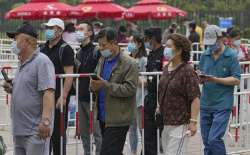Thousands of wild animals were sold in Wuhan markets months before COVID-19 outbreak: Report
The wild animals that were sold included mammals such as civet cats, mink and raccoon dogs, which are known to be susceptible to coronaviruses, along with squirrels, badgers, foxes and hedgehogs, as well as birds and reptiles.

Thousands of wild animals were sold in markets in the Chinese city of Wuhan ahead of the COVID-19 outbreak, according to new research. Wuhan, where the first coronavirus case was reported, is famous for the active trade of wild animals including mammals. In a detailed record of wild animal sales yet to be published, the British and Chinese researchers estimate that over 47,000 wild animals were sold in the city's markets two and a half years before the disease emerged.
In monthly site visits to 17 shops selling wild animals across four markets in Wuhan between May 2017 and November 2019, researchers documented the sale of 38 species.
These included mammals such as civet cats, mink and raccoon dogs, which are known to be susceptible to coronaviruses, along with squirrels, badgers, foxes and hedgehogs, as well as birds and reptiles.
Seven of the vendors monitored were at the Huanan Seafood Wholesale Market, which was linked to a number of the earliest known cases of Covid-19 in late 2019.
Some 1,100 individual animals were being moved through city markets on average monthly, in a trade that the researchers describe as both ripe for spreading disease and "fundamentally illegal".
"Almost all animals were sold alive, caged, stacked and in poor condition. Most stores offered butchering services, done on-site, with considerable implications for food hygiene and animal welfare," said the researchers, from China West Normal University and Oxford University, who received their data directly from stall owners as part of a study to monitor tick-borne disease.
The origin of coronavirus that causes COVID-19 has remained a mystery with scientists and countries calling for further investigations to figure out whether the virus originated naturally or leaked from a lab in Wuhan.
Zhou Zhao-min, one of the co-authors of the paper, said the data could not be shared during the review process.
The research was originally submitted in April last year but was rejected by several international journals before the submission to Scientific Reports in October, he said.
"I hope this data could be helpful to trace the origins of Sars-CoV-2 [the coronavirus that causes Covid-19]. For example, mink was on sale in the markets, while Sars-CoV-2 has been reported in mink farms in Europe and North America," Zhou said, adding that the paper also "highlights the shortages of wildlife management".
The Chinese authorities said that only frozen wild animals were found at the Huanan market and tested after it was closed on January 1, 2020.
The WHO team report, based on information from the Chinese authorities, only said that only snakes, crocodiles and salamanders - which are less likely to have been infected with coronaviruses - were being sold live in the market in late December 2019.
Yanzhong Huang, a senior fellow for global health at the Council on Foreign Relations in New York, said the latest research underlined that work conducted under the auspices of the WHO mission was "currently not thorough".
"They have not exhausted their research, which suggests more in-depth work needs to be done in China," he said.
(With ANI inputs)